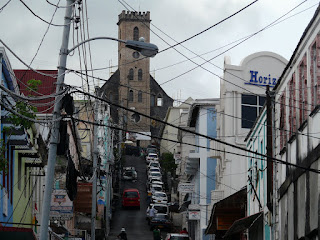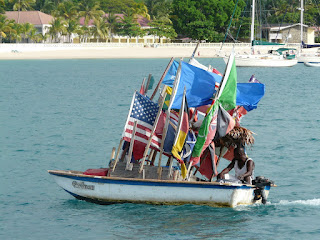
Grenada consists of three main islands, Grenada, Carriacou and Petite Martinique.
Grenada, a spectacularly beautiful island, has lush green mountains, crystal waterfalls, golden beaches, and the fragrant spice trees that give the island its epithet “Isle of Spice”. There are more spices per square mile than any other place on the planet. It produced 1/3 of the world’s nutmeg supply and was the second largest producer in the world of nutmegs prior to Hurricane Ivan which destroyed much of the island in 2004. Other spices grown include cloves, cinnamon, mace, ginger, bayleaves and turmeric.

This is a nutmeg. The fruit is dried and the nut extracted for export or it is crushed and sold locally. The red part surrounding the nut is dried and crushed and is the spice called Mace.
Grenada’s history has been lively, with early wars and revolutions. More recently, things got exciting with the transition to full independence from Britain in 1974. Most Granadians felt this was premature, and instead of jubilant celebrations, the island was on strike and in protest. Nonetheless, independence was thrust upon her, and Grenada came of age under the rule of Sir Eric Gairy, a flamboyant and controversial figure who was groomed by the British Government and monarchy to become the island’s first prime minister.
Gairy made early political missteps, such as using his first opportunity to speak in front of the UN to plead for more research into UFOs and the Bermuda Triangle. There were rumours of corruption, of ties with the notorious General Augusto Pinochet of Chile and of the use of a group of thugs called the Mongoose Gang to intimidate and eliminate adversaries. Power went to Gairy’s head.
Before dawn on 13 March 1979, while Gairy was overseas, a band of armed rebels supported by the opposition party (NJM) led a bloodless coup. Maurice Bishop, a young, charismatic, London-trained lawyer and head of the NJM became Prime Minister of the new People’s Revolutionary Government (PRG) regime.
Bishop attempted to turn Grenada into a socialist state, improving medical care and education, but he did so at the cost of freedom: anyone who opposed him was thrown in jail, and all independent newspapers were banned. A schism developed between Bishop and hardliners in the government who felt that he was incompetent and was stonewalling the advance of true Communism. The ministers voted that Bishop should share power with the hardline mastermind (and Bishop’s childhood friend) Bernard Coard. Bishop refused and was placed under house arrest. While Coard had the support of the majority of the government and the military, Bishop had support of the vast majority of the public.
On 9 October 1983, thousands of supporters spontaneously freed Bishop from house arrest and marched with him and other sympathetic government ministers to Fort George. The army was unmoved by the display and Bishop, his pregnant girlfriend (minister of Education Jacqueline Creft) and several of his followers were taken prisoner and executed by a firing squad in the courtyard. To this day, it is unclear if the order came directly from Coard – although most believe that it did.
Six days later, 12,000 US marines, along with a few soldiers from half a dozen Caribbean countries, were on Grenadian shores. 70 Cubans, 42 Americans and 170 Grenadians were killed in the fighting. Most of the US forces withdrew in December 1983, although a joint Caribbean force and 300 US support troops remained on the island for two more years. The US sunk millions of dollars into establishing a new court system to try Coard and 16 of his closest collaborators.
Fourteen people, including Coard and his wife, were sentenced to death for the murder of Bishop. Although the death sentences were commuted to life in prison in 1991, the most recent appeal for full clemency and release from prison was rejected in February 2005.
Another major event in Granada’s history happened on 7 September 2004 when Hurricane Ivan with winds of 193km/h slammed into Grenada from the south. The storm crashed directly into Grenada’s most heavily populated southern parishes, ripping rooves off homes, downing trees and electrical lines and tearing some structures from their foundations. Thirty-nine Grenadians died, and many public buildings and some 90% of homes were damaged. Nutmeg, cocoa, banana and other cash crops were devastated. The hurricane was followed by waves of desperate looting and vandalism. Many residents spent months without rooves or electricity and with only limited access to running water.
The country received massive support from other Caribbean nations and from countries around the world. Still today, when travelling around the island, one sees many derelict homes that have not been rebuilt and a large number of small pre-fabricated houses which were built to house the homeless dotting the landscape. Many public buildings and island infrastructure were rebuilt by individual countries and some of these were identified when Mal and I went on a one day island tour when we first arrived e.g.There was the bridge that was rebuilt by Japan and the stadium that was rebuilt by China. Australia also played a major role and when talking to the locals we are told of how wonderful the Australians were.
We arrived in Granada on Thursday, 18 June 2009 and anchored in a lagoon which is a located off the main port of St George, the capital of Granada. During the next two weeks, we anchored outside of the port as it was much cooler and the water was clearer than the lagoon which allowed us to swim off the back of the boat; we also motor sailed to Prickly Bay, anchoring there for a couple of days, and to Hog Island which is a little further around the south of the island. We found these areas to be quite isolated so decided to return and anchor once again outside of St George Harbour.
As we had originally planned to find a safe anchorage in Granada for the hurricane season which is from June to the end of October, Mal had priced all of the marinas and also the cost of putting Hasta La Vista on the dry with the possibility of us then travelling to the US for a holiday. The best price and the safest anchorage was at Port Louis Marina in St George. To secure the price one had to book in for four months, so on the 3 July, we tied up at Port Louis Marina. Port Louis Marina is a new partially built marina which is still being developed. It offers a small restaurant, a pool and amenities, and is located in St George Harbour. Mal doesn’t particularly like marinas, however, it will serve our purpose and we plan to sail to other bays and islands to the north occasionally. The best part for me is that I now have a little bit of independence and can visit downtown St George and the shopping malls without having to drag Mal along.

Hasta La Vista is the catamaran in the right of the picture. Downtown St George is in the background.

A view of Hasta La Vista from the pool.
The local buses consist of a large van which one flags down or waits at a bus stop until one passes. It is the equivalent of approximately $1 Australian to travel any distance within a certain boundary one way. We soon found our way around St George, the fruit and vegetable markets and the fish market as well as establishing where the best supermarkets were located.

A typical street in St George.

Markets in St George.

A fisherman selling the local delicacy, the “small jack”. The jack is rolled in flour and spices, deep fried and eaten whole.
Many cruisers are in Granada for the hurricane season and activities and outings are organised by the cruisers themselves and the marinas who have restaurant facilities. There is a cruisers net on VHF radio every morning six days per week where one is kept informed of the weather, social activities, etc. We have participated in happy hours and burger nights; taken a day tour around the island with two Aussi couples who just happened to have booked on the same day as we did and a South African couple; and have travelled to Gouyave which is a small fishing village on the west coast for their local fish fry night where the locals set up stalls and sell delicious seafood meals.

We have made very good friends with a Canadian couple, Doug and Wendy who have just purchased their first yacht, a catamaran, “Nahanni River”, and Nicholas and Lyn, an Australian couple from The Gold Coast who have just bought a mono, “Girl”, to renovate and sail back to Aus. We have spent many hours enjoying afternoon drinks, going around to the next bay for an afternoon swim and a pinacolada or going for a swim in the marina pool. And it’s great being able to go shopping with the girls!
Granada is famous for its beautiful rain forest and waterfalls. There were eight of us on “Cuddy’s” Island Bus Tour. Incidentally, six of the eight were Australians! “Cuddy” has a business taking cruisers wherever they want to go as well as offering day tours and transport to the Gouyave Fish Fry Night. We had a wonderful day visiting the Annandale falls, one of the falls in the centre of Granada; the River Antoine Rum Distillery on the north-eastern side of the island; a nutmeg sorting facility and a cocoa drying and export facility, as well as viewing much of the island along the way. Cuddy stopped and pointed out things of interest such as the different fruit and spice trees. He also gave us some of the recent history of the island including the time of Independence and of when Hurricane Ivan hit. Just north of Annandale Falls, as we came around a corner, Cuddy started hitting his horn. We were unsure of why until three monkeys came out of the forest and made there way to a log rail along the side of the road. Cuddy brought out some bananas and the monkeys came right up to cuddy and took them out of his hands.

Annandale Falls is only a small waterfall compared to those that are higher up and much more difficult to get to.

This fruit is cocoa. It is full of a white flesh covered seeds. These are dried and crushed to produce cocoa powder. You can experience the “cocoa taste” if you suck the flesh covered seeds.

This is the cashew fruit. The cashew nut is in the stem at the top. It is poisonous eaten raw but as we know, wonderful when roasted.





The Cocoa drying and exporting facility.

Cocoa beans.

Cocoa beans bagged and ready for export.

This is part of the River Antoine Rum Distillery. The sugar cane is crushed by the power of the water wheel.


The sugar cane is manually loaded.

The crushed sugar cane is sorted by hand.

This shows the piles of firewood prepared and ready to be fed into the furnaces underneath the large vats that boil and ferment the cane juice.

The labelling the bottle process!

Mal was quite happy behind bars in the rum tasting room!

The Nutmeg separating and drying facility.

Typical street stalls.















































